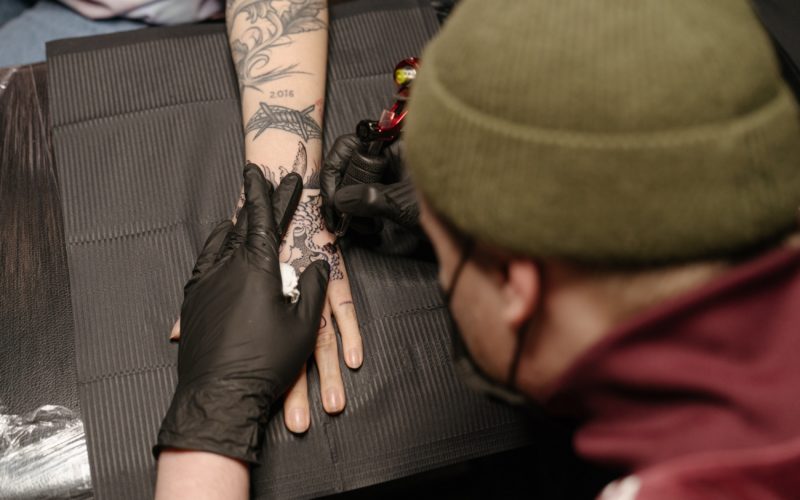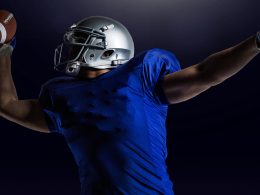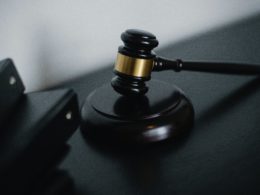Technology for a detailed tattoo has existed for centuries.1[1]See New York Historical Society: Tattooed New York (New-York Historical Society | Tattooed New York (nyhistory.org). Technology for a realistic digital depiction of an athletic contest has existed for much less.2[2]Larry Frum, Emerging Technology Heightens Video-game realism (Emerging technology heightens video-game realism – CNN); For an explanation of recent technology and the emerging realism, watch Unreal Engine 5 Revealed! | Next-Gen Real-Time Demo Running on PlayStation 5 – Bing video The recent intersection of the two presents a legal tension with which courts currently grapple.3[3]See John R. Faulkner, III, Not A Taboo Use of Tattoos: Why Using Unauthorized Replicas of Professional Athlete Tattoos in Video Games Constitutes Fair Use, 30 Marq. Sports L. Rev. 371 (2020).
“The Truth is in The Details”
In 2020, two federal district courts in different parts of the country were faced with the same issue: Under federal copyright law, does a video game creator, which copied an athlete’s tattoos to create a realistic depiction of that athlete in a sports game, infringe on the tattoo artist’s copyrighted work? For reasons relating to the differing states of the factual record and different analytical approaches to copyright infringement defenses, the courts issued divergent decisions.
In Illinois’s Alexander v. Take-Two Interactive Software, Inc., a tattoo artist alleged that a video game developer infringed on her copyrighted work by reproducing the tattoos in its game series.4[4]Alexander v. Take-Two Interactive Software, Inc., 489 F. Supp. 3d 812 (S.D. Ill. 2020). Between 2002 and 2008, tattoo artist Catherine Alexander inked six tattoos on Randy Orton, a professional wrestler in the World Wrestling Entertainment, Inc.5[5]Id. at 817. Within a few years, Take-Two Interactive Software, Inc., which develops, markets, and publishes video games through wholly-owned subsidiaries such as “2K,” copied these tattoos into several of its annual WWE 2K games.6[6]Id. Take-Two licensed from WWE and Orton the necessary intellectual property rights, but copied Alexander’s six tattoos in their entirety without separately licensing them.7[7]Id. at 817-18 (discussing “Photo Reference,” the process Take-Two utilized to replicate Orton. In Photo Reference, the videogame version of Orton is not a photograph of him, but a “digitally created, authentic, re-creation of photographs of Orton.”). The Alexander court declined to dismiss the copyright infringement claim because of “material factual disputes” as to: (1) Take-Two’s purpose for using the tattoo designs; and (2) whether Alexander and Orton had discussed “permissible forms of copying and distributing the tattoo [designs].”8[8]Id. at 820.
Almost 1,000 miles away9[9]According to Google Maps, the states are over 900 miles apart. , in the Southern District of New York, a tattoo licensing company found itself in a similar position to the tattoo artist in Alexander. In Solid Oak Sketches, LLC v. 2K Games, Inc., plaintiff Solid Oak claimed that Take-Two, the same defendant in Alexander, infringed on its copyrighted material.10[10]Solid Oak Sketches, LLC v. 2K Games, Inc., 449 F. Supp. 3d 333 (S.D.N.Y. 2020) Prior to 2013, several tattoo artists inked five tattoos on three NBA players–Lebron James, Kenyon Martin, and Eric Bledsoe.11[11]Id. at 339. Take-Two incorporated these tattoos into three versions of its annual NBA 2K game series: NBA 2K14, NBA 2K15, and NBA 2K16.12[12]Id.
Unlike in Alexander, the Solid Oak record established more facts, enabling the court to award summary judgment and dismiss the infringement claim. That record established detail about the game’s “many components, including graphics, characters, a fictitious plot, gameplay, and music,”13[13]Id. at 341. and use of “sound[s] of shoes against the court’s surface; the noise of the crowd…[and] television announcers performing play-by-play.”14[14]Id. Further, the record noted that each game includes 400 players,15[15]Id. at 342. and when a player is selected, any video game tattoo appears on screen around 4.4% to 10.96% of its real-life size.16[16]Id. The five tattoos at issue “comprise only a miniscule proportion of the video game data: only 0.000286% to 0.000431% of the [total game’s data].”17[17]Id.
The Solid Oaks record also did not present “material factual disputes” like those in Alexander. First, the record established that Take-Two’s purpose for incorporating the tattoos was to “accurately depict the physical likeness of the real-world basketball players as realistically as possible.”18[18]Id. at 341. Second, it was undisputed that the tattoo artists intended for these NBA players to display the tattoos in public. Each tattoo artist was aware that the tattoos would appear in media, like video games or commercials, as part of each player’s likeness.19[19]Id. at 340-342.
“God is in the Details”
Even taking into account these varying factual records, the courts took highly divergent approaches to the identical defenses Take-Two advanced in each case. Take-Two sought to justify its copying as proper based on: (1) an implied license, (2) fair use, and (3) de minimis use.20[20]Id.; Alexander, 449 F. Supp. 3d at 818. Close analysis of the courts’ holdings explains their dissimilarity.
In Illinois, the Alexander court declined to find an implied license because the parties disputed a key element of the test for that defense: “[whether] the licensor intend[ed] that the licensee-requestor copy and distribute her work.”21[21]Alexander, 449 F. Supp. 3d at 820. Because the Alexander court lacked sufficient facts to determine if Alexander intended for Orton to copy the tattoo, it could not properly resolve whether there existed an implied license.22[22]Id.
By contrast, the Solid Oak court granted summary judgment in favor of Take-Two on its implied license defense.23[23]Id. at *4. Although the Solid Oak court did not employ the same test, its decision similarly depended on the artist’s intention “[for] the [athlete to] copy and distribute” the tattoo.24[24]Id. This court explained that an “undisputed factual record” supported “the reasonable inference that the tattooists necessarily granted the [3 NBA players] nonexclusive licenses to use the [tattoos] as part of their likeness.”25[25]Id. As noted above, the Solid Oak court was aware of the fact that the tattoo artists intended for the NBA players to publicly display the tattoos.
Similarly, discrepancies in the factual record led the courts to rule differently on Take-Two’s fair use defense. Under federal law, fair use is determined by a four-factor test.26[26]17 U.S.C. § 107 When assessing the first factor, which looks at the “purpose and character of [the alleged infringer’s] use,” both the Alexander and Solid Oak courts evaluated whether the secondary use was “transformative.”27[27]Alexander, 449 F. Supp. 3d at 821 (conveying that “[a] use is appropriate or ‘fair’ where a defendant changes a plaintiff’s copyrighted work or uses the work in a different context such that the plaintiffs work is transformed into a new creation.”); Solid Oak Sketches, LLC., 449 F. Supp. 3d at 347 (explaining that “courts consider whether the allegedly infringing use is ‘transformative.’”). Typically, if a court finds that the allegedly infringing work is transformative, the court is likely to find that the work constitutes fair use.28[28]Jennifer Pitino, Has the Transformative Use Test Swung the Pendulum Too Far in Favor of Secondary Users?, 56 Advocate 26, 29 (2013) (noting that when courts place great weight on “transformative use and the first factor of the fair use test, [courts discount] the remaining three factors.” Pitino further notes that “courts today are virtually ruling 100% of the time that a transformative use is a fair use. This has in essence created a per se rule that transformative use is fair use.” Id.).
The Alexander court held that Take-Two’s fair use defense could not be resolved on summary judgment.29[29]Alexander, 449 F. Supp. 3d at 822. When evaluating the first fair use factor, the Alexander court found a “factual dispute…as to [Take-Two’s] purpose in using the tattoo works.”30[30]Id. at 821. The court learned that Alexander’s purpose in creating the tattoos was to display them on Orton’s body, but did not have sufficient facts regarding Take-Two’s purpose for displaying the tattoos, and whether that purpose was sufficiently transformative.31[31]Id.
In Solid Oak, the court found that Take-Two use of Solid Oak’s tattoos was sufficiently transformative to satisfy the fair use test. The court noted that the artists’ purpose in creating the tattoos differed from Take-Two’s purpose in displaying the tattoos.32[32]Solid Oak Sketches, LLC., 449 F. Supp. 3d at 347. Whereas the artists created the five tattoos “as a means for the [NBA players] to express themselves through body art,” Take-Two “reproduced the [five tattoos] in the video game in order to most accurately depict the [NBA players].”33[33]Id. Additionally, Take-Two significantly transformed the tattoo’s expressive value through reducing their size and incorporating a range of audiovisual elements as discussed above. Take-Two’s tattoo use was so transformative that “[g]ame users can see that the [p]layers have [t]attoos, but cannot identify the specific [t]attoos at issue.”34[34]Id. at 348.
As to Take Two’s de minimis use defense, the Alexander court expressed doubt as to the defense’s viability because of the absence of Seventh Circuit precedent, leaving the defense “an open question.”35[35]Alexander, 449 F. Supp. 3d at 823.
On the other hand, the Solid Oak court found sufficient Second Circuit precedent to award Take-Two summary judgment on its de minimis use defense.36[36]Solid Oak Sketches, LLC., 449 F. Supp. 3d at 345. That circuit’s de minimis use test requires the alleged infringer to show that its copying “is so trivial as to fall below the quantitative threshold of substantial similarity.”37[37]Id. at 344. Applying this test, the court held that a reasonable trier of fact could not find the artists’ tattoo designs were “substantially similar” to the tattoos as they appeared in Take-Two’s NBA 2K games.38[38]Id. at 345. As in its discussion of transformative use, the Solid Oak court reasoned that the tattoos appear on few players, in significantly reduced size, and are drowned out by other audiovisual elements.
“The Devil is in the Details”
While different factual records and legal precedent explain the court’s opposing holdings, one must ask: What impact does the Solid Oak court’s analysis have on all tattoo artists? Although the Solid Oak record “established” more facts than the Alexander record, the facts that were discussed in the Solid Oak opinion hold true to all video games. For all video games, any tattoo appearing on a video game avatar will constitute a small part of the game’s total audiovisual aspect and data. In other words, the Solid Oak court could apply the same analysis to all of Take-Two’s 2K game series and all video games in general. Such analysis places a hefty hurdle for tattoo artists to overcome. This hurdle can rise or fall as other courts begin to weigh in.
Written by: Christian Rivera
Christian is a 2022 J.D. Candidate at Brooklyn Law School
1 See New York Historical Society: Tattooed New York (New-York Historical Society | Tattooed New York (nyhistory.org).
2 Larry Frum, Emerging Technology Heightens Video-game realism (Emerging technology heightens video-game realism – CNN); For an explanation of recent technology and the emerging realism, watch Unreal Engine 5 Revealed! | Next-Gen Real-Time Demo Running on PlayStation 5 – Bing video
3 See John R. Faulkner, III, Not A Taboo Use of Tattoos: Why Using Unauthorized Replicas of Professional Athlete Tattoos in Video Games Constitutes Fair Use, 30 Marq. Sports L. Rev. 371 (2020).
4 Alexander v. Take-Two Interactive Software, Inc., 489 F. Supp. 3d 812 (S.D. Ill. 2020).
5 Id. at 817.
6 Id.
7 Id. at 817-18 (discussing “Photo Reference,” the process Take-Two utilized to replicate Orton. In Photo Reference, the videogame version of Orton is not a photograph of him, but a “digitally created, authentic, re-creation of photographs of Orton.”).
8 Id. at 820.
9 According to Google Maps, the states are over 900 miles apart.
10 Solid Oak Sketches, LLC v. 2K Games, Inc.,449 F. Supp. 3d 333 (S.D.N.Y. 2020)
11 Id. at 339.
12 Id.
13 Id. at 341.
14 Id.
15 Id. at 342.
16 Id.
17 Id.
18 Id. at 341.
19 Id. at 340-342.
20 Id.; Alexander, 449 F. Supp. 3d at 818.
21 Alexander, 449 F. Supp. 3d at 820.
22 Id.
23 Solid Oak Sketches, LLC., 449 F. Supp. 3d at 346.
24 Id.
25 Id.
26 17 U.S.C. § 107
27 Alexander, 449 F. Supp. 3d at 821 (conveying that “[a] use is appropriate or ‘fair’ where a defendant changes a plaintiff’s copyrighted work or uses the work in a different context such that the plaintiffs work is transformed into a new creation.”); Solid Oak Sketches, LLC., 449 F. Supp. 3d at 347 (explaining that “courts consider whether the allegedly infringing use is ‘transformative.’”).
28 Jennifer Pitino, Has the Transformative Use Test Swung the Pendulum Too Far in Favor of Secondary Users?, 56 Advocate 26, 29 (2013) (noting that when courts place great weight on “transformative use and the first factor of the fair use test, [courts discount] the remaining three factors.” Pitino further notes that “courts today are virtually ruling 100% of the time that a transformative use is a fair use. This has in essence created a per se rule that transformative use is fair use.” Id.).
29 Alexander, 449 F. Supp. 3d at 822.
30 Id. at 821.
31 Id.
32 Solid Oak Sketches, LLC., 449 F. Supp. 3d at 347.
33 Id.
34 Id. at 348.
35 Alexander, 449 F. Supp. 3d at 823.
36 Solid Oak Sketches, LLC., 449 F. Supp. 3d at 345.
37 Id. at 344.
38 Id. at 345.




